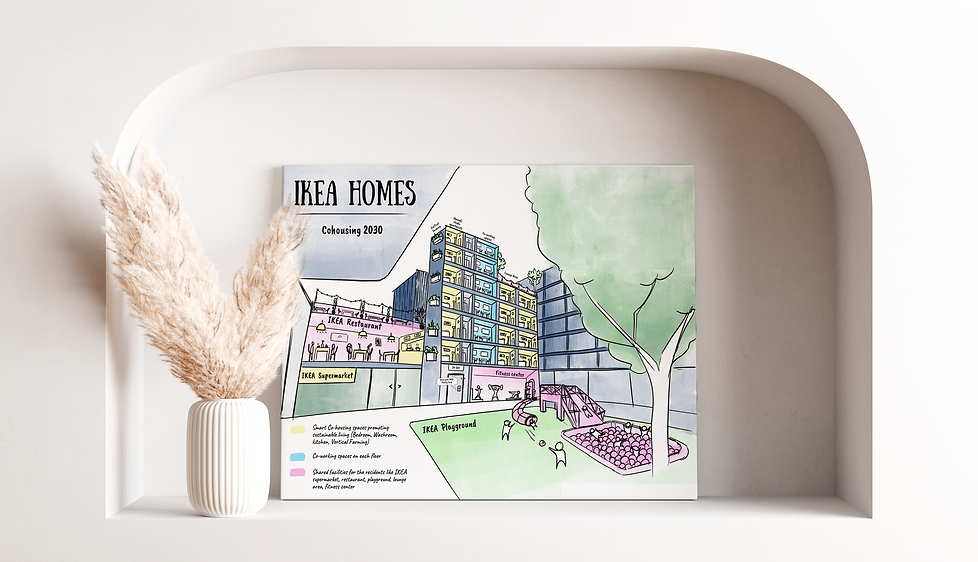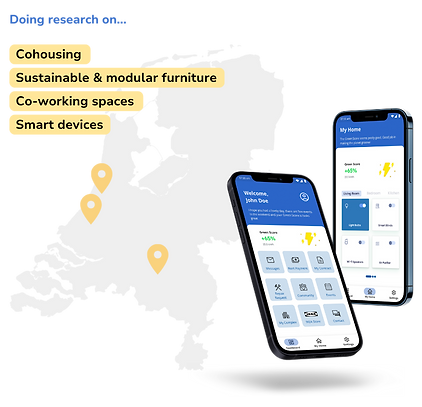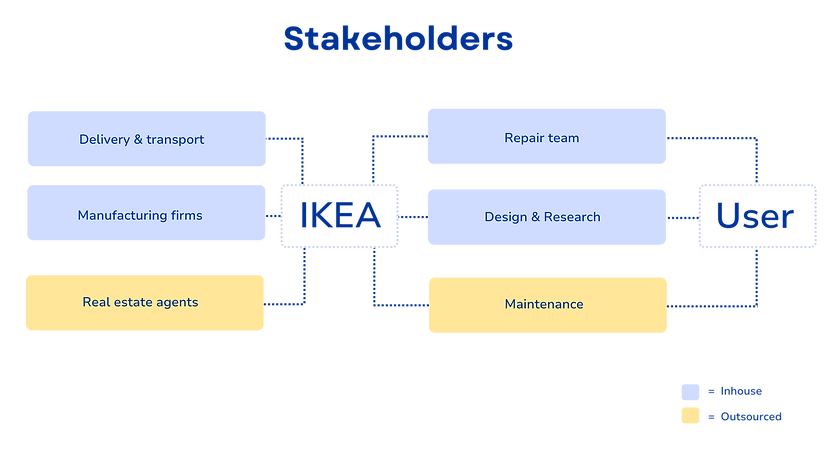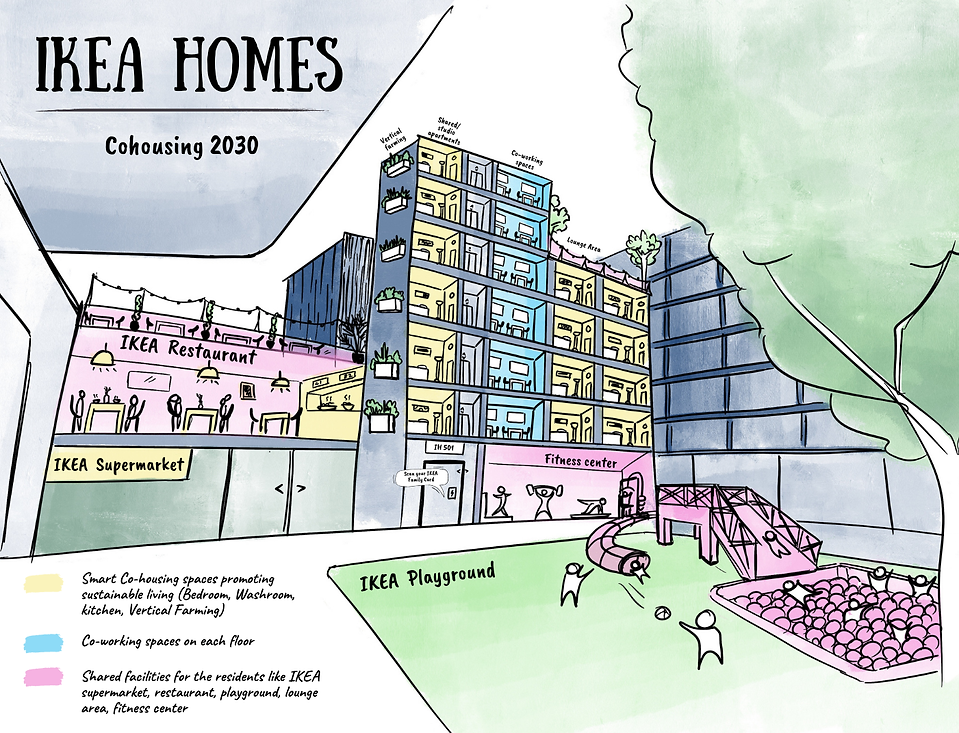IKEA HOMES
Dive into the vision of IKEA Homes, a project set to transform the housing landscape by providing affordable and sustainable cohousing solutions, fostering a sense of community and environmental responsibility by 2030.
Duration
Oct 2022 - Nov 2022
Project Nature
Team Project
Role
Strategy Designer

Future Vision
By 2030, IKEA will be a leader in cohousing by offering affordable sustainable housing solutions, which enhances social connection.
Cohousing
Social Connection
Affordable Sustainability
Embracing the future, we envision IKEA leading the way in cohousing by 2030, offering affordable sustainable housing solutions that amplify social connections. Cohousing, as an intentional community blending private homes with shared spaces, lies at the heart of this vision. Embracing this intentional shift toward communal living reflects our belief that architecture should align with lifestyles, promoting flexibility and community-centric designs. The significance of this vision lies in addressing the increasing demand for cohousing spaces, the evolving concept of ownership towards leasing/sharing, and the fundamental question of whether architecture should adapt to our lives.
Focus on Cohousing
The future vision centers on cohousing, recognizing it as an intentional community of private homes and shared spaces. This evolution resonates with the growing trend in cohousing spaces and a shift from ownership to more flexible and communal living arrangements.
Affordable Sustainability
Aligned with IKEA's 2030 sustainability goals, the vision emphasizes making sustainability affordable for the majority through cohousing. By sharing resources, reducing living costs, and embracing
the circular economy, the vision sets a
new standard for affordable and sustainable living.
Enhancing Social Connection
Acknowledging the widespread problem of loneliness, experienced by 47% of people in the Netherlands, the future vision prioritizes social connection. Cohousing emerges as a solution, inspired by sources like the book Ikigai, associating social support with increased life expectancy and underscoring the societal impact of this approach.
ROADMAP FOR IKEA HOMES 2030

Horizon 1 - Entering the real estate market
In the first horizon, IKEA strategically enters the real estate market by collaborating with DUWO to establish the IKEA Hostel, designed as an innovative approach to introduce the concept of cohousing. This collaboration, particularly targeting students, signifies IKEA's initial steps into the housing sector. By offering flexible renting options for furnished spaces, IKEA aims to familiarize early adopters with the cohousing concept. Simultaneously, the launch of the IKEA Hostel serves as a compelling marketing stunt, creating a low-threshold environment for coliving experiences. This dual initiative not only positions IKEA within the housing market but also establishes a tangible connection with potential cohousing enthusiasts, setting the foundation for the transformative journey ahead.
Shared Space

Horizon 2 - User Research and Buying Real Estate
Building on insights gained from the first horizon, IKEA progresses to the second horizon with the introduction of "IKEA Home," a strategic move involving the acquisition of existing buildings. This phase prioritizes user research, aiming to understand evolving user needs. Expanding its user base to include Students and Young Urban Professionals (YUPs), IKEA strategically enhances its value proposition by offering affordable and accessible services tailored to these demographics. Through "IKEA Home," the company not only provides an array of new products and services but also lays the groundwork for extensive user research, a crucial step in realizing its future vision. This horizon represents a significant leap toward achieving cohousing goals by incorporating valuable insights from diverse user experiences.
Shared Time


Target Cities and Services Focus
Strategically centering its services in Rotterdam, Eindhoven, and Leiden—cities renowned for their dynamic job and educational sectors—IKEA Home caters primarily to Young Urban Professionals and students. The research agenda encompasses co-housing dynamics, modular furniture services, sustainable product use, integration of co-working spaces and cafeterias, and the inclusion of smart devices. Monthly visits by IKEA's design team and architects to three real estate locations foster continuous dialogue with residents, extracting invaluable insights and refining the understanding of the ideal IKEA home through user reviews and firsthand experiences, paving the way for a transformative future vision.
CO-LIVING CANVAS: HORIZON 2 STORYBOARD

Real Estate Business

Maintenance

Housing Interior
Changes for IKEA
Recognizing the imperative to strengthen relationships within the real estate sector, IKEA will embark on a strategic expansion of its design team, bringing aboard additional interior designers exclusively focused on crafting furniture tailored for cohousing environments. The management of home maintenance will undergo an externalization process, a move strategically designed to optimize operational efficiency and streamline the user experience. These proactive shifts underscore IKEA's commitment to a user-centric approach, with the design and research team taking the lead in incorporating invaluable user input. As these changes unfold, the stakeholder map will dynamically evolve, revealing the key collaborators essential to realizing Horizon 2's progressive vision for IKEA Homes.

Horizon 3 - Building IKEA Homes
IKEA takes a bold step forward by designing and constructing the ideal IKEA Homes, incorporating valuable insights gathered from the previous horizon. The focus remains on enhancing social connections through sustainable and affordable housing solutions. This phase envisions an expansion of IKEA Homes, fostering a more diverse community that includes families alongside its initial demographic. The initiative not only creates value for individuals but also resonates with broader societal benefits. It instills a mindset that sustainability is an affordable option for everyone, spearheading a shift from individual to shared ownership. Most significantly, cohousing emerges as a catalyst for building social cohesion, embodying community at its best.
Shared Value




In the Design Strategy Project (DSP) course spanning five weeks, our collaborative team of five strategic product designers, including myself, delved into identifying a compelling design opportunity for a market disruptor. Selecting IKEA, renowned for its innovative and affordable home solutions, we built upon a week-long initial analysis from a prior module. Throughout the project, my role involved active participation in team planning and leadership, particularly during the ideation phase. In the project's concluding stages, I contributed to crafting the value proposition and stakeholder mapping for the roadmap. Additionally, I took part in creating essential prototype sketches, including the overview sketch and storyboard, with collaborative input from a fellow team member.
Special thanks to
Team
Isa Buitenhuis, Lot Hartevelt,
Ujjayan Dhar and Wenhan Yu
Coaches
Fernando Secomandi and Margot Weltje
Tools used in the project
